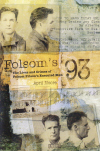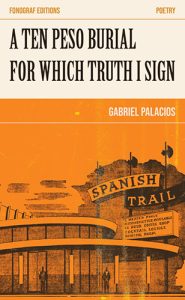Folsom’s 93
The backstory of Folsom’s 93: The Lives and Crimes of Folsom Prison’s Executed Men would make a pretty good book of its own. Author April Moore’s great-great-aunt Betty, a “fiery redhead” who worked in Los Angles nightclubs, was married to Tom, a professional gambler and bookie with ties to LA and Las Vegas crime syndicates. If that wasn’t enough to keep family phone lines and dinner conversations buzzing, Tom had photos and dossiers of all 93 men executed at Folsom Prison between 1895 to 1937. Why he had them is a mystery; they came into his possession following a visit to the prison to collect a debt from a prisoner. After Betty’s death, the author acquired, as her grandfather labeled them, “the ugly mugs.” Moore follows this irresistible film noir of an introduction with straightforward accounts of how the condemned went to the gallows.
The backstory of Folsom’s 93: The Lives and Crimes of Folsom Prison’s Executed Men would make a pretty good book of its own. Author April Moore’s great-great-aunt Betty, a “fiery redhead” who worked in Los Angles nightclubs, was married to Tom, a professional gambler and bookie with ties to LA and Las Vegas crime syndicates. If that wasn’t enough to keep family phone lines and dinner conversations buzzing, Tom had photos and dossiers of all 93 men executed at Folsom Prison between 1895 to 1937. Why he had them is a mystery; they came into his possession following a visit to the prison to collect a debt from a prisoner. After Betty’s death, the author acquired, as her grandfather labeled them, “the ugly mugs.” Moore follows this irresistible film noir of an introduction with straightforward accounts of how the condemned went to the gallows.
Each chapter includes a profile of a prisoner with details of his crime (or crimes), trial, and date of execution. The method of execution was always hanging. Moore filled in what the photographs and brief descriptions do not reveal with a history of Folsom (possibly written by an unnamed prisoner) that Uncle Ted also had, as well as through newspaper articles, police records, and court papers.
The matter-of-fact detailing of events in the entries does not make for dull reading. These individual stories are not only mini-biographies but also an informal history of California. The San Francisco that came into existence out of the Gold Rush was a culturally diverse boomtown attracting the rich, poor, migrant, and immigrant. The transition from agrarian to urban brought with it problems of settlement rights, land development, worker exploitation, and immigration that major cities all over the world confront. In 1880 Folsom, located 20 miles northwest of Sacramento, became home to the second oldest prison in the state and one of the first maximum-security facilities in the nation. (According to the prison’s Mission Statement, Folsom now “primarily houses Medium Security General Population Level II male inmates.”)
Folsom is also part of music history thanks to Johnny Cash’s classic “Folsom Prison Blues” and his 1968 concert performance there. However, not even The Man in Black can disguise the prison’s substantially documented history of harsh treatment and conditions—the primary motivation behind two riots in in 1903 and 1937 that resulted in murdered guards and escaped convicts.
Several of the condemned confessed without coercion. James Berry not only told acquaintances that he shot his wife Alice, he willingly turned himself in. During his trial, he said would “blow her up” again if given the chance. However, others were sentenced due to hearsay, inconclusive testimony, racism, or in the case of Chin Hane, all three. Chin’s facial scar matched that in the description the widow of a murdered merchant gave the police. The press found him guilty before the trail due to his “villainous” appearance. Despite testimony not placing him at the crime scene, which took place during a neighborhood disturbance erupting in gunfire, he was hanged.
The 1905 San Francisco Earthquake did not affect Folsom. Nevertheless, as Warden James Johnson observed, it temporarily “scared the sin out of some people.” Ways of committing a crime change. While not foolproof or incorruptible, forensics, checks and balances on local and federal law enforcement, the Miranda Rights Act, and testimony from social behaviorists have made interpreting the impulse to harm slightly easier to understand. Adolph Julius Weber might have benefitted from modern psychiatry. Convicted in 1906 for murdering his family and setting their home on fire to make it look like an accident, Weber displayed signs associated with paranoia (delusional, loss in primary interests, increased physical activity, egotism, mutilation of animals, violent outbursts) . . . findings not made public until two years after his execution.
Wyoming and Missouri are considering the return of firing squads to carry out the death penalty with the valid arguments that the drugs needed for lethal injection are costly and do not work quickly. Would a firing squad further romanticize the practice as in paintings and movies, or be the next step in the (de)evolution of reality television? Supporters might want to heed the words of James Johnson, who served as Warden not only at Folsom but San Quentin and Alcatraz as well. “Every execution upset me, I could not get used to them . . . not even when it seemed the logical ending to a lawless life.”
Whether changes in carrying out the severest form of corporal punishment are made or not, it is important to consider all parties involved. Even the bad guys deserve that, and the forgotten criminals in this book are worth learning about.





